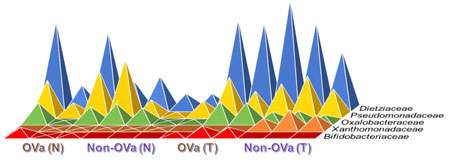Scientists discover unsuspected bacterial link to bile duct cancer

An international research collaboration has identified bacteria in the bile duct as a potential risk factor in the development of bile duct cancer, or Cholangiocarcinoma (CCA), a rare but aggressive form of cancer with symptoms that do not present themselves at the early stages.
CCA is associated with multiple risk factors that are geographically distinct – choledocal cysts and primary sclerosing cholangitis have been implicated in the development of CCA in Western populations, while infections by the liver fluke parasite have resulted in higher incidence of CCA in Southeast Asia. However, the role of bacteria in CCA development has not been previously established, despite their relatively well-characterised involvement in colon and gastric (GI tract) cancers.
To address this gap, the team of researchers profiled the tissue microbial community of liver fluke-infected and non-infected CCA based on the 16S ribosomal RNA (rRNA) gene, a highly conserved marker gene for studying different bacterial lineages.
Led by first author Dr Chng Kern Rei, Senior Research Fellow of Computational & Systems Biology at Agency for Science, Technology and Research (A*STAR)'s Genome Institute of Singapore (GIS), Singapore, the team discovered that bile duct tissue harboured a community of diverse bacteria species. Stenotrophomonas species – previously implicated in bile duct infections – were found to be preferentially dwelling in tumour tissue (compared to normal tissue) of non-fluke-infected CCA patients, highlighting their potential role in development of CCA.
In comparison to non-fluke-infected CCA tissues, fluke-infected CCA tissues were found to contain enteric bacteria whose metabolic outputs (bile acids and ammonia) have been previously linked to carcinogenesis, or the formation of cancers. Taken together, the results suggest a role for bile duct tissue microbiome in development of CCA and which may accordingly be used as a target for therapy.
Besides main collaborator National Cancer Centre Singapore (NCCS), this multi-national, multi-institutional project also involved National University of Singapore, Singapore General Hospital, and Duke-NUS Medical School from Singapore; Fundeni Clinical Institute from Romania; Khon Kaen University from Thailand; and Massachusetts General Hospital and Harvard Medical School from the United States. Published in scientific journal EBioMedicine's June 2016 issue, the study was also featured on the cover.
"Until recently, our understanding of bacterial communities resident in our body and their association with diseases has been limited. The associations detected in this study provide a smoking gun for the role of bacteria in bile duct cancer, and we hope that this discovery will accelerate our search for a cure for cholangiocarcinoma," said Dr Nagarajan, the study's joint corresponding author and Principal Investigator of Computational & Systems Biology at the GIS.
"Understanding how our cells interact with our environment and in this case our "microbial self" is increasingly recognized to be important for our understanding of health and disease. Such fundamental research while still in its early stages may pave the way for novel therapeutic strategies in time as the microbiome is far more manipulable than our genome. We are grateful to NMRC for their support in this study," said Dr Joanne Ngeow, Co-Principal Investigator of this study and Senior Consultant Medical Oncologist, National Cancer Centre Singapore.
GIS Executive Director Prof Ng Huck Hui said, "Microbiome studies are an increasingly important area of research, evident in the National Microbiome Initiative launched by the Obama administration recently. Enabled by cutting-edge technologies at GIS, I look forward to more studies in this area with a view to understanding the role of microbial communities in diseases, and eventually leading to better health outcomes for patients."
More information: Kern Rei Chng et al. Tissue Microbiome Profiling Identifies an Enrichment of Specific Enteric Bacteria in Opisthorchis viverrini Associated Cholangiocarcinoma, EBioMedicine (2016). DOI: 10.1016/j.ebiom.2016.04.034

















